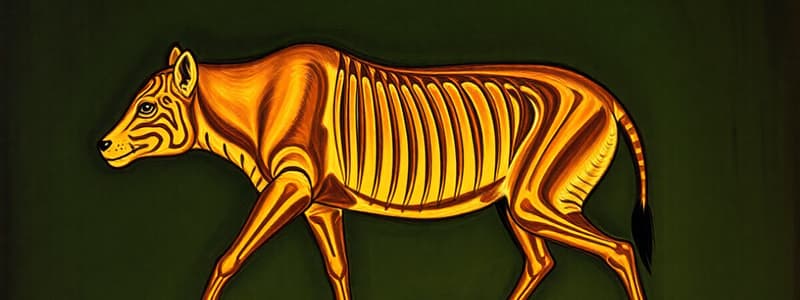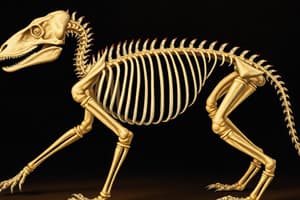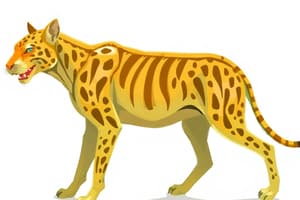Podcast
Questions and Answers
Which of the following is NOT a shared characteristic among most members of the animal kingdom?
Which of the following is NOT a shared characteristic among most members of the animal kingdom?
All animals exhibit bilateral symmetry.
All animals exhibit bilateral symmetry.
False (B)
What are the three germ layers found in triploblastic animals?
What are the three germ layers found in triploblastic animals?
Ectoderm, mesoderm, and endoderm
The [BLANK] is the middle germ layer found in triploblastic animals.
The [BLANK] is the middle germ layer found in triploblastic animals.
Signup and view all the answers
Match the following animal body symmetries with their descriptions:
Match the following animal body symmetries with their descriptions:
Signup and view all the answers
Flashcards
Animal Classification
Animal Classification
System that categorizes animals based on anatomy, evolution, and genetics.
Eukaryotic
Eukaryotic
Organisms with cells that have a nucleus, part of the animal kingdom.
Body Symmetry Types
Body Symmetry Types
Asymmetrical, radial, and bilateral are the three main types of body symmetry.
Germ Layers
Germ Layers
Signup and view all the flashcards
Coelom
Coelom
Signup and view all the flashcards
Study Notes
Animal Diversity
- Animal classification is based on anatomy, morphology, evolutionary history, embryological development, and genetic makeup
- Animals are eukaryotic, multicellular, heterotrophic, develop into motile creatures with fixed body plans
- Unique to the animal kingdom is differentiated tissues (e.g., nerve, muscle, connective)
- Most animals reproduce sexually, with similar developmental stages across the kingdom
Body Symmetry
- Most animals are bilaterally symmetrical (except those with radial symmetry)
- Asymmetrical animals have no symmetry
- Radial symmetry: body parts arranged around a central axis (e.g., top/bottom, no left/right)
- Bilateral symmetry: body can be divided into mirror images along a sagittal plane (e.g., left/right)
Germ Layers
- Most animals have germ layers that develop during gastrulation, differentiating into tissues/organs
- Diploblasts (e.g., radial symmetry): two layers (endoderm, ectoderm); non-living layer between
- Triploblasts (e.g., bilateral symmetry): three layers (endoderm, ectoderm, mesoderm)
Internal Body Cavity
- Triploblastic animals may develop a coelom (internal body cavity derived from mesoderm) or not
Studying That Suits You
Use AI to generate personalized quizzes and flashcards to suit your learning preferences.
Description
Test your knowledge on animal classification, body symmetry, and germ layers. This quiz covers key concepts such as bilateral, radial symmetry, and the significance of germ layers in animal development. Explore a variety of fascinating topics related to the diverse animal kingdom.




